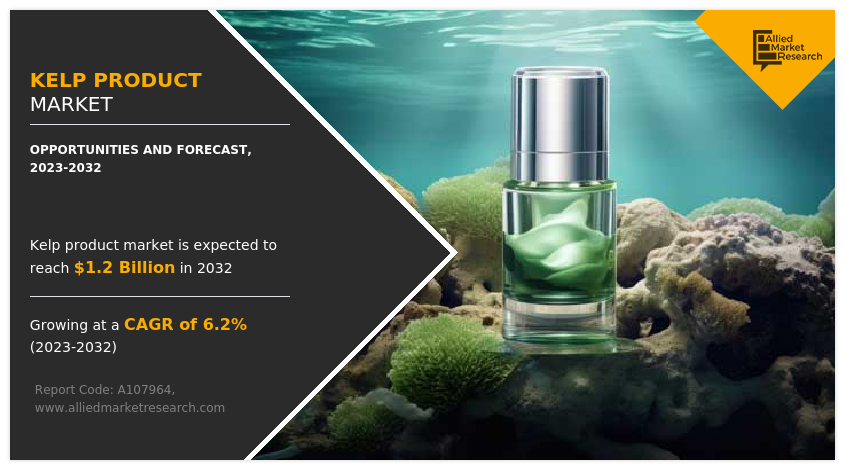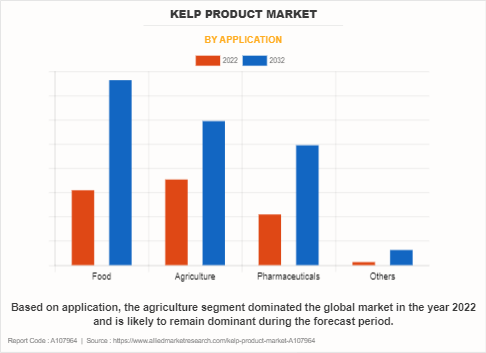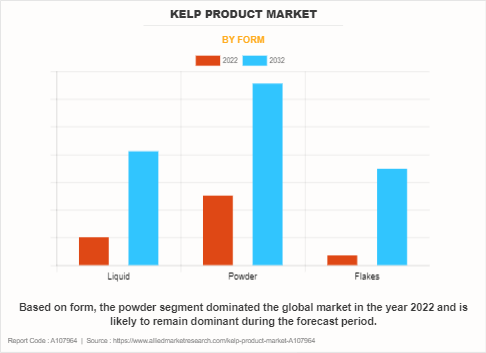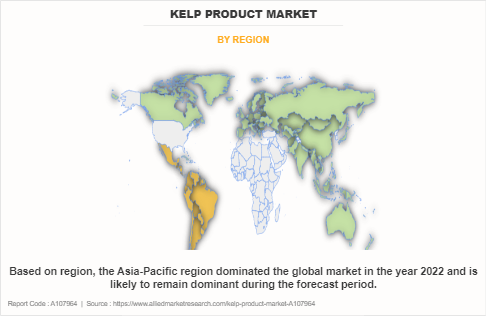Kelp Product Market Research, 2032
The global Kelp Product Market Size was valued at $643.4 million in 2022, and is projected to reach $1.2 billion by 2032, registering a CAGR of 5.9% from 2023 to 2032. Kelp products encompass a diverse range of items derived from kelp, a type of brown algae. One significant component extracted from kelp is alginate, a carbohydrate used as a thickening agent in various products such as ice cream, jelly, salad dressing, and toothpaste. Kelp finds applications in the production of toothpaste, shampoos, salad dressings, puddings, cakes, dairy products, and frozen foods. The alginate extracted from kelp contributes to the viscosity and texture of these products.

Market Dynamics
Rising demand for natural ingredients and the diverse applications of kelp-derived substances
Kelp's versatility extends beyond the culinary and personal care realms. Kelp forests, which are underwater ecosystems with dense kelp growth, play a vital role in marine environments, providing habitats for various marine species and contributing to overall biodiversity.
The global Kelp Product Industry for kelp products is driven by the demand for natural ingredients and the diverse applications of kelp-derived substances. As interest in sustainable and environmentally friendly products grows, kelp products continue to gain prominence across industries, showcasing the versatility and potential of this marine resource.
Utilization of seaweed for human consumption as food product accounts for the highest Kelp Product Market Share and is anticipated to continue this trend during the forecast period. Substances that are extracted from seaweeds such as hydrocolloids make up most of the remaining market share, while smaller applications such as fertilizers, animal feed additives, aquaculture, biomass for fuel, and wastewater treatment make up the rest.
Increase in awareness about the health benefits of seaweed
Seaweed is a rich source of minerals, most prominently calcium, copper, iodine, and iron. In addition, it is rich in protein, fiber, and vitamins, such as vitamin K and folic acid, while being low in calories and fats, and are mostly included in the Southeast Asian diet. Furthermore, as inhabitants from these countries have migrated to other parts of the world, the Kelp Product Market Demand for seaweed as food has increased. Increase in awareness about the health benefits of seaweed among the people in North America and Europe further drives the Kelp Product Market Growth. In addition, multiple benefits associated with kelp products increase their application in various sectors. For instance, seaweed and kelp products (SWE) have been used as soil amendments and fertilizers in agriculture. Traces of macro- and micronutrient elements, such as amino acids, vitamins, cytokinins, auxins, abscisic acid-like compounds, and quaternary ammonium compounds in seaweeds, are useful for the growth of vegetation. Moreover, seaweed finds application in wastewater treatment. The effluent water from fish farms usually contains high levels of waste that cause problems to other aquatic life. Seaweeds absorb heavy metal ions such as zinc and cadmium from the polluted water and purify the water in areas adjacent to fish farms. Furthermore, the commercial applications of seaweed have grown due to increase in R&D activities by various key players in the seaweed industry, which are anticipated to foster the market growth during the Kelp Product Market Forecast period.
Change in climatic conditions can hamper the Kelp Product Industrygrowth
The cultivation of seaweed majorly depends upon the climatic conditions and air moisture content. Warm climate affects the cultivation of seaweed, as warm climate causes evaporation of water and prevents formation of thicker seaweed. On the contrary, moisture content is responsible for providing seaweed with minerals and nutrients. Climate changes cause draught and change in salinity of freshwater, which result in death of seaweed, thus hampering their production capacity. Furthermore, change in rainfall pattern caused due to climate change leads to intense storm. This storm causes runoff of essential nutrients from the cultivation ponds and hampers the production of seaweed. In addition, coastal upwelling pushes deep sea water from sea to the surface, bringing nutrients from ocean bed to earth surface. This coastal upwelling hampers production of seaweed species harvested from the sea bed. Hence, fluctuating climatic conditions affect the cultivation of seaweed, eventually restraining the market growth.
On the contrary, the seaweed farming industry has developed in some countries of North America and Europe, unlike Asia-Pacific, where it is still in its nascent stage. In the recent years, the European policies have driven the development of seaweed cultivation as part of the European Union Blue Growth initiative. In support to this initiative, the countries across Europe are providing subsidies to study the possible applications of seaweeds across various end-use industries. Moreover, interest in seaweed cultivation has been peaking in recent years in North America, owing to its nutritional value as well as its richness in iron and protein content.
Segment Overview
The global kelp products market is segmented into product type, application, form, and region. Depending on product type, the market is classified into dried, fresh, and salted. On the basis of application, it is segregated into food & beverage, pharmaceuticals, personal care & cosmetics, and others. By form, it is fragmented into liquid, powder, and flakes. Region wise, it is analyzed across North America, Europe, Asia-Pacific, LA, and MEA.
By Type
Based on type, the fresh type segment dominated the global market in the year 2022 and is likely to remain dominant during the forecast period. The increased consumer preference for fresh and natural products, driven by a growing awareness of health and environmental concerns, has significantly contributed to the surge in demand for fresh kelp products. Fresh kelp is perceived as a healthier alternative to processed or dried forms, as it retains higher nutritional value and original flavors.
Moreover, the fresh type segment benefits from the rising popularity of various culinary trends and the incorporation of kelp into diverse dishes, ranging from salads to soups and sushi. This growing culinary versatility has expanded the appeal of fresh kelp products beyond traditional markets, attracting a broader consumer base globally. Additionally, the fresh type segment aligns with the increasing focus on sustainable and locally sourced food products, further boosting its market share.
Furthermore, advancements in supply chain logistics have facilitated the efficient transportation of fresh kelp, overcoming geographical constraints and enabling wider distribution. As the demand for nutritious and sustainably sourced foods continues to rise, the fresh type segment is expected to maintain its dominance in the global kelp products market, catering to the evolving preferences and priorities of consumers worldwide.
Based on type, the Fresh Type segment dominated the global market in the year 2022 and is likely to remain dominant during the forecast period.
By Type
By Application
Based on application, the agriculture segment dominated the global market in the year 2022 and is likely to remain dominant during the forecast period. This is attributed to attributed to the widespread adoption of advanced technologies and innovative applications that enhance efficiency and productivity in farming practices. The integration of precision agriculture, smart farming solutions, and automated machinery has revolutionized traditional farming methods, optimizing resource utilization, minimizing environmental impact, and increasing overall yields. These technological advancements not only streamline operations but also contribute to sustainable and eco-friendly farming practices, aligning with global efforts to address food security and environmental challenges.
Furthermore, the agriculture segment's dominance can be attributed to the growing global population, which necessitates an increase in food production. The demand for high-quality, nutritious, and diversified crops is driving farmers and agribusinesses to invest in cutting-edge technologies that offer data-driven insights, real-time monitoring, and predictive analytics. Precision agriculture tools, such as drones, sensors, and GPS-guided machinery, play a pivotal role in optimizing planting, harvesting, and irrigation processes. As the world grapples with climate change and resource scarcity, the agriculture sector's commitment to sustainable practices positions it as a key player in the market's trajectory, ensuring its continued dominance in the years to come.

By Form
Based on form, the powder segment dominated the global market in the year 2022 and is likely to remain dominant during the forecast period. Firstly, powder products are versatile and can be used in various industries such as food and beverage, pharmaceuticals, cosmetics, and household products. This broad applicability makes them highly sought after by manufacturers and consumers alike. Additionally, powdered products often have a longer shelf life compared to their liquid or solid counterparts, making them more convenient for storage and transportation. Furthermore, advancements in powder processing technology have led to the development of high-quality powdered products with improved solubility, texture, and taste, further driving demand. Moreover, the powder segment benefits from being more cost-effective to produce and package compared to other forms, making them an attractive option for manufacturers looking to optimize their production costs. Looking ahead, the powder segment is likely to remain dominant during the forecast period as the demand for convenience, cost-effectiveness, and versatility continues to drive consumer preferences and industry trends. Additionally, ongoing innovations in powder formulation and processing technology are expected to further enhance the appeal and functionality of powdered products, solidifying their position as a dominant force in the global market.

By Region
Based on region, the Asia-Pacific region dominated the global market in the year 2022 and is likely to remain dominant during the forecast period. The Asia-Pacific region has been a focal point for technological innovation and advancements, particularly in sectors like information technology, manufacturing, and finance. This technological prowess, combined with strategic investments in research and development, positions the region as a global leader in innovation, attracting international businesses and bolstering its market dominance.
Additionally, favorable government policies, infrastructure development, and strategic alliances among nations within the region further contribute to its competitive edge. With an expanding market share in industries ranging from automotive and electronics to healthcare and finance, the Asia-Pacific region is poised to remain the driving force behind global market trends, making it a key player in the evolving economic landscape during the forecast period.

Competitive Analysis
The players operating in the global market have adopted various developmental strategies to increase their market share, gain profitability, and remain competitive in the market. The key players included in the kelp products market analysis are Marinalg International, The Seaweed Company, Acadian Seaplants Limited, Ocean Harvest Technology, Cargill, Inc., Seasol International Pty Ltd, Maine Coast Sea Vegetables, Inc., Chase Organics, Kimnori USA LLC, AlgAran Seaweed Products, Seakura, Pacific Harvest, Gelymar SA, Atlantic Mariculture Ltd., and Mara Seaweed.
Key Benefits for Stakeholders
- This report provides a quantitative analysis of the market segments, current trends, estimations, and dynamics of the kelp product market analysis from 2022 to 2032 to identify the prevailing kelp product market opportunities.
- The market research is offered along with information related to key drivers, restraints, and opportunities.
- Porter's five forces analysis highlights the potency of buyers and suppliers to enable stakeholders make profit-oriented business decisions and strengthen their supplier-buyer network.
- In-depth analysis of the kelp product market segmentation assists to determine the prevailing market opportunities.
- Major countries in each region are mapped according to their revenue contribution to the global market.
- Market player positioning facilitates benchmarking and provides a clear understanding of the present position of the market players.
- The report includes the analysis of the regional as well as global kelp product market trends, key players, market segments, application areas, and market growth strategies.
Kelp Product Market Report Highlights
| Aspects | Details |
| Forecast period | 2022 - 2032 |
| Report Pages | 249 |
| By Type |
|
| By Application |
|
| By Form |
|
| By Region |
|
| Key Market Players | Gelymar SA, Algama, Cargill Incorporated, CP Kelco, Acadian Seaplants Limited, Irish Seaweeds, DuPont de Nemours, Inc., Ocean Harvest Technology, Roullier Group |
Analyst Review
In the culinary realm, kelp is utilized for its unique umami flavor and nutritional richness. Common kelp products include kelp noodles, often used as a gluten-free alternative in various dishes, and kelp powder, which can be incorporated into soups, smoothies, or used as a seasoning. Kelp's nutritional profile is noteworthy, as it is a rich source of vitamins, minerals, and antioxidants, contributing to its reputation as a health-conscious ingredient.
Increase in consumer awareness related to the health benefits of seaweed and its extracts has significantly driven the growth of the global kelp products market in past few years. Kelp products are widely known for their high nutritional content as they contain essential vitamins, minerals, and nutrients such as iodine, vitamins A, C, E, B, omega3 fatty acids, and other antioxidants. As a result of the increasing focus on health consciousness, consumers are actively seeking products that promote overall well-being, and kelp products are well-aligned with this prevailing trend. These extracts are increasingly integrated into functional food and dietary supplements to address specific health concerns, including the support of gut health, thyroid function, and inflammation reduction. There are some kelp products, such as alginate, which have been associated with weight management and digestive health benefits. This attracts customers seeking healthy weight maintenance and enhanced overall well-being. These extracts have gained huge prominence in skincare and cosmetic formulations owing to their moisturizing, anti-aging, and anti-inflammatory properties.
Moreover, sustainability is a major concern for consumers, and seaweed—owing to its low ecological footprint and environmentally friendly growth characteristics—serves as a convenient and ecologically responsible choice. As consumers become more ecologically aware, they are inclined toward products that align with their sustainability objectives, which thus renders kelp products as an attractive option. The ongoing research efforts and educational initiatives by industry stakeholders and healthcare professionals have strengthened consumer understanding of the multiple health benefits of kelp products. Thus, rise in consumer awareness of the health benefits associated with kelp products has boosted the continued expansion of the kelp products market.
However, price volatility of kelp products presents a challenge for the growth of kelp products market. In addition, climate change and environmental fluctuations have impacted seaweed growth conditions, which affect yields and quality of the produced kelp products. Supply chains are prone to disruptions such as transportation delays and labor shortages, which may further result in shortages or surplus of kelp products. Thus, it may cause suppliers to hesitate to commit to fixed price contracts. Seaweed farming involves a large number of stakeholders that affect price movement. In addition, the absence of organized Kelp Product Industryfor establishing international benchmark prices for seaweed complicates pricing decisions. Pricing is often based on incomplete or inaccurate information. The significant price difference of kelp products in between regions persists due to the absence of a global market, and this is worsened by the fact that most trade occurs through bilateral contracts. As a result of increase in consumer demand for seaweed extract products owing to health-conscious trends, sudden shifts in preferences and surge in demand may affect supply chains and exert upward pressure on prices of the final products. The unpredictability of seaweed extract prices may disrupt business operations by causing uncertainty in budgeting and financial planning related to products made with addition of kelp products in them. This volatility increases competition, leading to price wars that reduce profit margins and discourage investments in research and development. Furthermore, price volatility is expected to hamper the steady growth of the market.
The global Kelp Product market size was valued at USD 643.4 million in 2022, and is projected to reach USD 1.2 billion by 2032.
The global Kelp Product market is projected to grow at a compound annual growth rate of 5.9% from 2023-2032 to reach USD 1.2 billion by 2032.
The key players profiled in the reports includes Gelymar SA, DuPont de Nemours, Inc., Roullier Group, Irish Seaweeds, Ocean Harvest Technology, Algama, Cargill Incorporated, Acadian Seaplants Limited, CP Kelco.
Asia-Pacific dominated in 2022 and is projected to maintain its leading position throughout the forecast period.
Rising demand for natural ingredients and the diverse applications of kelp-derived substances, Increase in awareness about the health benefits of seaweed majorly contribute toward the growth of the market.
Loading Table Of Content...
Loading Research Methodology...


